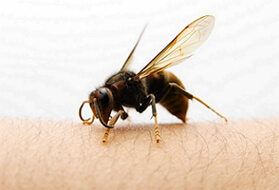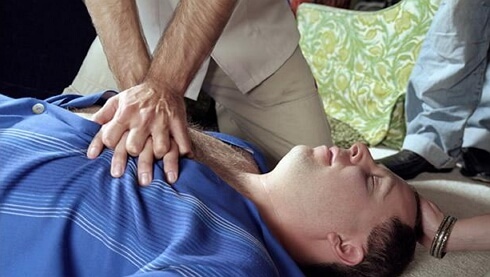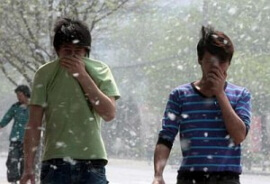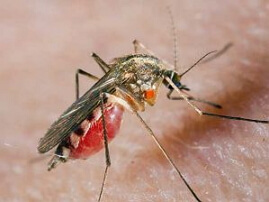Anaphylactic shock
 Anaphylactic shock is a life-threatening acute serious pathological condition, the main cause of which is repeated contact with a certain provoking allergen. Virtually any substance that has entered the body( food, insect bites, pollen, etc.) can cause anaphylactic shock. This condition is the most formidable complication of drug allergy, as in about 15% of cases a lethal outcome is observed.
Anaphylactic shock is a life-threatening acute serious pathological condition, the main cause of which is repeated contact with a certain provoking allergen. Virtually any substance that has entered the body( food, insect bites, pollen, etc.) can cause anaphylactic shock. This condition is the most formidable complication of drug allergy, as in about 15% of cases a lethal outcome is observed.
Anaphylactic shock is an acute allergic reaction of an immediate type in which the fusion of the antibody + antigen leads to the release of biologically active substances in the bloodstream such as bradykinin, serotonin and histamine, which cause spasm of the muscles of the internal organs, disrupt blood circulation in small blood vesselsAnd increase the permeability of the blood vessels of the hematopoietic system. As a consequence, blood begins to accumulate on the periphery, blood pressure drops, the brain and internal organs do not get enough oxygen, a loss of consciousness occurs.
Anaphylactic shock from the onset of contact with a provoking allergen occurs( develops) from a few seconds to two hours. If the patient has a high degree of sensitization, neither the mode of administration nor the dose of the allergen plays a decisive role. However, the greater the dose of an allergenic drug, the longer and more severe the shock is.
Anaphylactic shock can occur in everyday life, in principle, any person in any period of life. Sometimes this can occur as a result of taking any medication( more often antibiotics), after anesthesia in the dental office, after an insect bite, or during the tasting of an exotic dish. From other allergic reactions, anaphylactic shock primarily differs in the severity of the manifestations of the disease. Fortunately for allergy sufferers, this does not mean that anaphylactic shock always ends in a fatal outcome, since in the case of adequate timely medical care most of these reactions are resolved safely. However, people who have ever had anaphylactic shock in the future should always have an "allergy passport" with an exact reason for what exactly this reaction was recorded, as well as a syringe with adrenaline( epinephrine), in the case of a second episode of anaphylacticShock
Anaphylactic shock - symptoms
The degree of severity of the clinical picture of anaphylactic shock directly depends on the speed of development of violations of the brain and vascular collapse.
For an easy degree of anaphylactic shock( develops from a few minutes to two hours), the following symptoms are typical: increasing weakness, headache, discomfort in different parts of the body, feeling hot, tachycardia, hypotension, dizziness, rhinorrhea, sneezing, itching, flushing of skin.
For the average severity of anaphylactic shock, an even more detailed clinical picture is characteristic: conjunctivitis, toxicermy, Quincke's edema, stomatitis, circulatory disorders-lowered blood pressure, heart pain, arrhythmia, palpitations, severe weakness, agitation, anxiety, visual impairment, pallor, Trembling, fear of death, hearing loss, cold sticky sweat, noise and ringing in my head, fainting. Against the background of these manifestations, an obstructive syndrome like an attack of bronchial asthma with the presence of gastrointestinal( sharp pains in the abdomen, feces of blood, diarrhea, swelling of the tongue, bloating, nausea, vomiting) and kidney( polyuria, urge to urinate) syndromes can develop, As well as with the advent of cyanosis.
With a severe degree of anaphylactic shock, a fulminant collapse( sudden decrease in blood pressure, filiform pulse, cyanosis, pallor), coma( loss of consciousness with involuntary urination and defecation), pupils dilated, no reaction to light. In the case of a further fall in blood pressure, the pulse and blood pressure cease to be determined, the heart stops, the breathing stops.
Possible variants of anaphylactic shock, in which the predominant lesion is observed:
• Nervous system. It is accompanied by the development of severe headache, paresthesia, hyperesthesia, the appearance of nausea, seizures with involuntary defecation and urination, loss of consciousness with epileptic clinical manifestations of
• Skin. It is manifested by intolerable skin itching, hives, Quinck's edema, hyperaemia
• Hearts. It is manifested by the development of a picture of myocardial infarction or acute myocarditis
• Respiratory organs. Because of the edema of the larynx, asphyxia
develops due to altered upper airway patency. Possible allergens capable of causing anaphylactic shock: vaccines, radiocontrast agents, anesthetics, nonsteroidal anti-inflammatory drugs and antibiotics. The cause of anaphylactic shock can be even an allergen-specific immune therapy or carrying out allergic skin tests. Anaphylactic shock is often developed under the influence of food allergens( seafood, peanuts, etc.).Often, the cause of this condition are bites of various insects.
Anaphylactic shock - emergency care
1. In the shortest time, you should call an ambulance, because with anaphylactic shock there is a high risk of cardiac arrest or breathing, so the patient requires compulsory medical supervision and drug treatment
2.In the event that a person experiences a loss of consciousness and does not breathe, even before the ambulance arrives( because it may not be in time!), One should independently conduct a cardiopulmonary resuscitationation. In the overwhelming majority of cases, it saves the life of a person
3. If the patient is conscious and breathing, he should be properly laid:
• if he is conscious but has difficulty breathing, he should be given a reclining position or sit down
• in case of complaints onStrong weakness, the patient should be laid on a flat surface, putting a folded blanket or pillow
4 under his feet. In case this is possible, the allergen-causing
5, which caused anaphylactic shock, should be removed from the body. Ae if the shock was caused by the use of any product, the remains of
6 should be removed from the patient's mouth. If an anaphylactic shock was caused by a bee sting, it is necessary to try to remove the stinging residue from the place of bite
. Anaphylactic shock should be provided instantaneously, asEven a second delay or confusion of the doctor can cause the death of the patient 
What if anaphylactic shock has already been there once?
1. The attending physician should find out the exact cause of the development of this condition. If it was a medication, then its name should be remembered forever and when you enter the hospital or with other possible contacts with medical workers, you should always report an allergic reaction to this medicine. In case the allergen has been served by a certain food product, it should be completely abandoned both from it and from products where it is even present with minimal quantities of
2. The nearest environment of anaphylactic shocked person should learn in time to recognize the first symptoms of the allergic reaction that has begun and in the caseThe emergence of these signs without delay to call emergency care
3. Friends and relatives of the patient should learn to conduct cardiopulmonary resuscitation, since thisIs often the only chance for survival of
4. In some cases, the patient may be advised to carry always the so-called "allergy passport" and an adrenaline filled syringe. Friends and / or relatives should always know exactly where the syringe is and how to use it properly.



